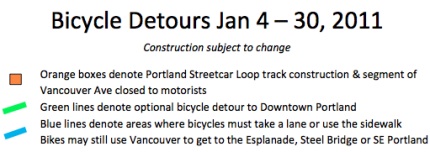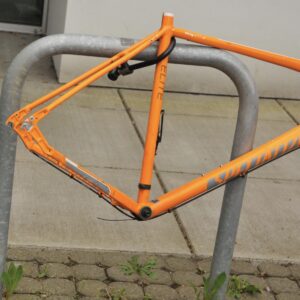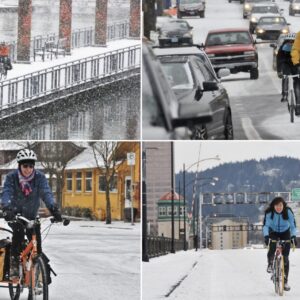A traffic advisory has just been released by Portland Streetcar Inc. and the City of Portland warning of traffic detours and a bike lane closure due to Streetcar Loop Project construction on Weidler, MLK, and Grand that is set to begin this Tuesday (1/4) and last for four weeks.
The work zone will be on NE Weidler from N. Ross to NE 1st Ave (see detour map below)s. For four weeks, NE Weidler will be narrowed to two vehicle lanes and, according to Portland Streetcar, “Due to the narrow roadway conditions, the bike lane on NE Weidler must be removed.”
To maintain bicycle traffic flow, the plan is to guide bicycle operators onto the sidewalk between Benton Avenue and the I-5 off-ramp near Victoria Avenue. Here’s another excerpt from the traffic advisory:
Cyclists will be guided to use the sidewalks between Benton Ave and the I-5 off ramp/Victoria Ave. Cyclists should be aware of and yield to pedestrians. Cyclists should use the crosswalk at pedestrian speeds at all intersections on Weidler. Extra care should be used to cross at Vancouver/Weidler, due to the high volume of right turning vehicles.
In addition, N. Vancouver will be closed from Tillamook to Broadway. If you are riding a bike toward downtown Portland you are encouraged to detour off of Vancouver and over to Flint to continue westbound. If you are headed southwest on Vancouver toward the Esplanade or Southeast Portland, you can use Vancouver, but here’s the warning:
“Cyclists… must cross with the pedestrian signal on the east side of Broadway/Vancouver as the traffic signal for Vancouver will be turned off. Cyclists must then move into the travel lanes between Broadway and Weidler to get to the bike lane south of Weidler. Heavy traffic congestion is expected in this area.”
Below are the detour maps (download PDF here):







Considering Weidler is already on my list of streets to avoid for biking, I think that with Streetcar construction being added I will happily avoid it entirely.
I have been using Williams and Vancouver to come from or go to North Portland I will plan on using Flint street instead or head over to Hancock, Schuyler or Halsey for my east bound rides.
i do appreciate that the map says “take a lane or.” the bike lane through here is restrictive enough. forcing bikes to the sidewalk would be much worse. it would be helpful if they put up some “expect bikes in the roadway” signage, but i don’t suppose they will.
Hmm. I’m thinking using the Steel Bridge is a better route out of Downtown than chancing the sidewalks, especially on an active Rose Garden night. For those of us who cross the Broadway Bridge, that is.
Last summer they closed N Vancouver Ave at Tillamook and it was chaos for the drivers and bicyclists both. I live on Tillamook between Williams and MLK, and we had about 200 cars per hour detouring east on Tillamook. And delivery trucks, semis, and one Trimet bus.
I think they should close N Vancouver at Russell instead. Russell can handle that sort of traffic — it has a center line, it has a traffic light at Williams, and it is not a bike arterial.
If you care about riding Tillamook (or care about others that do) how about shooting an email to safe@portlandoregon.gov and asking them to divert N Vancouver Ave traffic at Russell, not Tillamook.
Thanks,
Ted Buehler, and my neighbors…
Or encourage PBOT to not do things that endanger both cyclists and pedestrians alike, like encouraging driving on the sidewalk.
[My usual rant about how rail-based transit is bad for bicycling, why does the BTA not fight this tooth and nail, etc., etc., goes here.]
Agreed, I’m not sure how much money they’re spending, inconvenience they’re creating, and time they’re wasting to install the streetcar when buses are already doing the job at a fraction of the price.
Add on top of that the addition of miles of new bike hazards and this thing has boondoggle written all over it.
While the initial investment cost is high, the cost of operation over the long haul for rail equipment is much lower than for buses. Heck, we’re still using Bombardier LRVs built in 1983; I believe the oldest bus in TriMet’s fleet right now is 15 years newer than that. Electricity is also cheaper than gasoline, especially when you consider that the trains make electricity just by engaging the brakes.
As for hazards created by tracks, rail channels, especially the type used by the Portland Streetcar, are minor hazards in the grand scheme of things. Perhaps you would like padded lampposts and cushy pavement while we’re at it?
But a fair comparison has to include that initial investment in the cost of rail equipment. Say rail equipment does last longer, either measured in years or measured in miles travelled. Part of the cost of that rail equipment is the railroad it operates on.
As far as electricity being cheaper than gas, why not trolley buses like I see in Seattle?
Although I’m not aware of such a system, I’d really like to see plug-in hybrid buses. If there’s a catenary, they hook up to it and run on electricity. If there isn’t, they run on battery or diesel. When they get back to the bus barn, they get recharged. I bought a Prius a few years ago, they are supposed to be coming out with plug-in hybrid cars real soon now. Why not the same technology on a bus?
I have been supremely out of love with the Streetcar since it was first introduced. It’s little more than an expensive toy train meant to lure some downtown residents — and mostly tourists — to shopping districts both real (i.e., the Pearl) and imagined (i.e., South Waterfront). Expanding more REAL passenger rail (in the form of more MAX lines or even high-speed heavy rail, with rail cars that actually hold a more cost-effective number of passengers) would have been a better use of the public’s money.
But now that it’s here, all that’s left is for us to figure out where not to ride. Go ahead and write to your elected officials if it will make you feel better, but this thing is a done deal and all the letters and emails in the world won’t shrink or even divert it.
The Škoda streetcars used by Portland are available in lengths up to 15 segments long in odd-numbered increments: If one of those 15-segment streetcars stopped at Pioneer Square South (never mind it’s a MAX platform), the back of said streetcar would be at the Fox Tower Pizza Schmizza. These streetcars also feature couplers, allowing multiple units to operate as a train (these are hidden under the retractable bumper when the car is at the end of a train for crash compatibility). Why Portland decided to go with the smallest streetcar Škoda makes and single-car operation is up for debate.
I think the downtown trolleys are a good thing. And it’s not as if they’re some sort of unexpected hazard leaping out at anyone; the tracks are right there embedded in the road, and where they are is where they’re going to stay.
I’d /much/ rather see streetcars pulling tourists and residents out of their cars than the mysteriously preferred option of packing the roads full of single-occupant vehicles which can kill bicyclists without any legal jeopardy as long as the driver remembers the get-out-of-jail phrase of “he just rode out into traffic without signalling!”
I suspect that if you asked the merchants who paid for the trolley line about the feasability of block-long station stops a’la the interurban you’d get various degrees of profanity-filled objections along the lines of “you’ll take on-street parking away over my dead body.”
The ridership on the downtown trolley (12000 boardings a day on weekdays) is nothing to sneeze at, either.
That’s a false dichotomy. There are other options besides streetcar and SOVs, such as buses, which don’t require rail.
For the inexperienced rider, or the rider who is not familiar with the route, the tracks _are_ an unexpected hazard.
I’d much rather cycle next to streetcars than buses. The city I went to school in had a rolling stock of nearly 1000 streetcars, and buses were not allowed in the center for safety/pollution/road & building damage concerns, and maneuverability benefits. This environment is much more desirable to me, rather than buses. However, on the main streets they ran in the middle of the street with the car lanes on the outside which enabled them to travel quite fast, and they mixed on the small streets with little auto traffic. Still, I would love it if there were streetcars wholly took the place of buses downtown – and I cycle quite regularly. Just my 2c.
At least in the United States, the general rule is that streetcars attract more ridership than busses do; If the increase in ridership that happened when the #5 bus was replaced with the interstate MAX line is any indication, about 8000 of the 12000 rides on the downtown trolley line are from people who would otherwise be driving. And I certainly prefer to not deal with those additional car trips when I’m going through downtown.
Also use caution when riding on the sidewalk as there will surely be construction signage in the way.
I have to ask the question if this is a ‘platinum’ quality detour and workzone plan for cyclists given the importance of these route segments. Has the BAC had the opportunity to review and comment on the this detour plan, etc.?
Is this the best that can or should be done? There are known models of best practice out there.
Will these detour routes have any upgrades to facilitate this traffic:
– orange detour sharrows and signs (?),
– widened/ separated marked bike crosswalks (ala Dutch standards),
– sidewalk ramps checked for lips, lifts, poles, sign boards, or other bike hazards (pot holes),
– opportunities for supplemental signage alerting motorists to expect faster non-pedestrian traffic using sidewalks/ crosswalks/ driveway crossings,
– temporary removal of some on-street parking to open up sight lines/ vision triangle at intersections given higher speeds of cyclists on sidewalks?
– establishing a buffered contraflow bikeway to avoid this workzone; on and on and on…
Perhaps the Bikeportland readership have additional recommendations?
i have been to pretty much every BAC meeting for over a year, and i would say no, this was not reviewed by the BAC
I only went to one BAC meeting in the last year and I’m not surprised that this wasn’t reviewed. After all, it’s a project the City wants. Why? Because the streetcar is currently fashionable. Why? I don’t know. Maybe it provides photo ops for elected officials at ribbon cutting ceremonies.
In any case, if the BAC reviewed it, someone at the BAC might object. And how does that objection help promote one of the City’s pet projects? It doesn’t. So, PBOT, which from what I saw sets the BAC agenda, doesn’t put it on the agenda. And so BAC doesn’t review it.
Orange is only used for marking centerlines. Counterflow bike lanes on a route this major is just asking for collisions at intersections.
Funneling bikes onto the sidewalk is a bad bad idea. Besides the inherent bike/pedestrian issues, we are going to be much more vulnerable at every driveway, alley and street intersection. Telling us to cross every single street at “pedestrian speed” is insulting. Will the vehicle traffic be subject to a 5 mph limit in these areas as well? After all, all of these bike inconveniences are for “our safety” while they do their construction. I will personally feel a lot safer as I ride in the middle of one of the traffic lanes and hope that there aren’t any major collisions between bikes riding on sidewalks and pedestrians or vehicles.
again: the advisory says “take a lane or.” no one is requiring anyone to ride on the sidewalk. i have seen plenty of people on bikes take the north side of the broadway bridge eastbound (counterflow) so they can ride sidewalks along the north side of broadway until they get to wheeler or flint or wherever. this is just a serving suggestion (though a rather poor one).
Actually it is Oregon State Law that requires bicycles to cross the streets at pedestrian speed if they are using a pedestrian crosswalk. This is not new, but not well-known.
See ORS 814.410(d)
So they are not “insulting” us. Just reminding us what the law is.
IMO, this is an insult. To any cyclist who is not comfortable taking the lane (and we need to be concerned about them as well) it is an insult regardless of how long the law has been in place. Everyone on these routes will be inconvenienced. However, they are taking steps to minimize the impact on cars and show less concern for bikes. Requiring bikes to slow to 5 mph at every intersection is not reasonable for commuting. Suggesting that a large number of us ride the sidewalk, which puts bikes and pedestrians in a more dangerous situation, is not acceptable.
Todd — nice work laying the problem out in technical terms. Thanks!
Ted Buehler
This is from the 1996 Bike Plan —
************
A1. Sidewalk Bikeways
Early bikeway efforts were aimed at multiple use of sidewalks for pedestrians
and bicyclists.
While in rare instances this type of facility may be necessary, or desirable for use
by small children, in most cases it should be avoided.
Sidewalks are generally not suited for cycling for several reasons:
• They put cyclists in conflict with pedestrians.
• There are potential conflicts with utility poles, sign posts, benches and other
“street furniture.”
• Bicyclists face conflicts at virtually every driveway, alley or intersection, as
motorists are not expecting bicyclists.A cyclist on a sidewalk is generally not
visible to motorists, so that the cyclist emerges unexpectedly. This is especially true of cyclists riding in the direction opposite to adjacent motor vehicle traffic—drivers are not looking for a vehicle coming from this direction.
• Bicyclists are put into awkward situations at intersections where they cannot
safely act like a vehicle but are not in the pedestrian flow either, which creates confusion for other road users.
Cyclists are safer when they are allowed to function as roadway vehicle operators, rather than as pedestrians.
****************
Nuff said…
page A23
And here’s the link to the 1996 plan
http://www.portlandonline.com/shared/cfm/image.cfm?id=40414
Thankfully they have left the light at Vancouver and Broadway ON. Seriously, they want me to take a hard right across a freeway off ramp, use the crosswalk, and dart back into a congested road with no bike lane? Not safe people. Not safe.